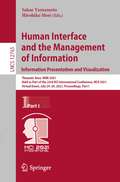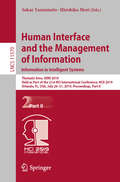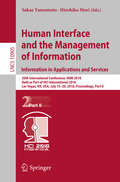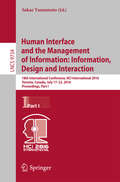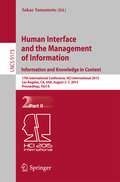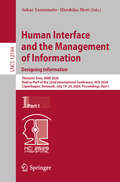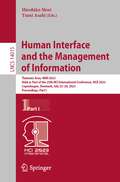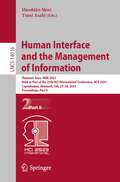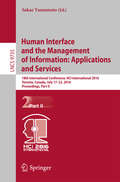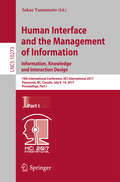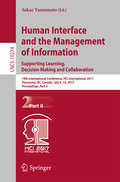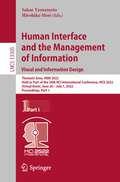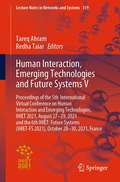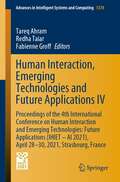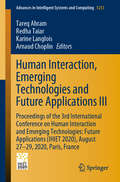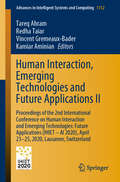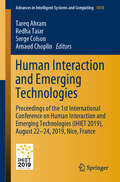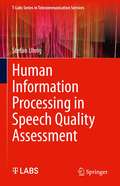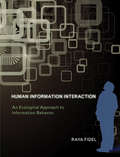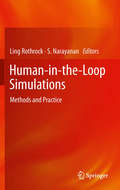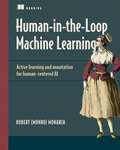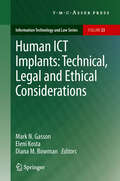- Table View
- List View
Human Interface and the Management of Information. Information Presentation and Visualization: Thematic Area, HIMI 2021, Held as Part of the 23rd HCI International Conference, HCII 2021, Virtual Event, July 24–29, 2021, Proceedings, Part I (Lecture Notes in Computer Science #12765)
by Sakae Yamamoto Hirohiko MoriThe two-volume set LNCS 12765-12766 constitutes the refereed proceedings of the thematic area Human Interface and the Management of Information, HIMI 2021, which was held as part of HCI International 2021 and took place virtually during July 24-29, 2021.The total of 1276 papers and 241 posters included in the 39 HCII 2021 proceedings volumes was carefully reviewed and selected from 5222 submissions. The papers included in the HCII-HIMI volume set were organized in topical sections as follows: Part I: Information presentation; visualization and decision making support; information in VR and multimodal user interfaces; Part II: Learning in information-rich environments; supporting work, collaboration and design; intelligent information environments.
Human Interface and the Management of Information. Information in Intelligent Systems: Thematic Area, HIMI 2019, Held as Part of the 21st HCI International Conference, HCII 2019, Orlando, FL, USA, July 26-31, 2019, Proceedings, Part II (Lecture Notes in Computer Science #11570)
by Sakae Yamamoto Hirohiko MoriThis two-volume set LNCS 11569 and 11570 constitutes the refereed proceedings of the Thematic Area on Human Interface and the Management of Information, HIMI 2019, held as part of HCI International 2019 in Orlando, FL, USA.HCII 2019 received a total of 5029 submissions, of which 1275 papers and 209 posters were accepted for publication after a careful reviewing process. The 91 papers presented in the two volumes were organized in topical sections named: Visual information; Data visualization and analytics; Information, cognition and learning; Information, empathy and persuasion; Knowledge management and sharing; Haptic and tactile interaction; Information in virtual and augmented reality; Machine learning and intelligent systems; Human motion and expression recognition and tracking; Medicine, healthcare and quality of life applications.
Human Interface and the Management of Information. Information in Applications and Services: 20th International Conference, HIMI 2018, Held as Part of HCI International 2018, Las Vegas, NV, USA, July 15-20, 2018, Proceedings, Part II (Lecture Notes in Computer Science #10905)
by Sakae Yamamoto Hirohiko MoriThis two-volume set LNCS 10904 and 10905 constitutes the refereed proceedings of the 20th International Conference on Human Interface and the Management of Information, HIMI 2018, held as part of HCI International 2018 in Las Vegas, NV, USA, in July 2018.The total of 1170 papers and 195 posters included in the 30 HCII 2018 proceedings volumes was carefully reviewed and selected from 4373 submissions.The 53 papers presented in this volume were organized in topical sections named: interacting with information; information and learning; information in aviation and transport; intelligent systems; and sevice management.
Human Interface and the Management of Information:Information, Design and Interaction
by Sakae YamamotoThe three-volume set LNCS 8016, 8017, and 8018 constitutes the refereed proceedings of the 15th International Conference on Human-Computer Interaction, HCII 2013, held in Las Vegas, NV, USA in July 2013. The total of 1666 papers and 303 posters presented at the HCII 2013 conferences was carefully reviewed and selected from 5210 submissions. These papers address the latest research and development efforts and highlight the human aspects of design and use of computing systems. The papers accepted for presentation thoroughly cover the entire field of human-computer Interaction, addressing major advances in knowledge and effective use of computers in a variety of application areas. This volume contains papers in the thematic area of human interface and the management of Information, addressing the following major topics: interacting with information, information searching, browsing and structuring, design and development methods and tools for interactive systems and services, personalized information and interaction, cognitive and emotional aspects of interacting with information.
Human Interface and the Management of Information. Information and Knowledge in Context
by Sakae YamamotoThe two-volume set LNCS 9172 and 9173 constitutes the refereed proceedings of the Human Interface and the Management of Information thematic track, held as part of the 17th International Conference on Human-Computer Interaction, HCII 2015, held in Los Angeles, CA, USA, in August 2015, jointly with 15 other thematically similar conferences. The total of 1462 papers and 246 posters presented at the HCII 2015 conferences were carefully reviewed and selected from 4843 submissions. These papers address the latest research and development efforts and highlight the human aspects of design and use of computing systems. The papers accepted for presentation thoroughly cover the entire field of human-computer interaction, addressing major advances in knowledge and effective use of computers in a variety of application areas. This volume contains papers addressing the following major topics: context modelling and situational awareness; decision-support systems; information and interaction for driving; information and interaction for learning and education; information and interaction for culture and art; supporting work and collaboration; information and interaction for safety, security and reliability; information and interaction for novel advanced environments.
Human Interface and the Management of Information. Designing Information: Thematic Area, HIMI 2020, Held as Part of the 22nd International Conference, HCII 2020, Copenhagen, Denmark, July 19–24, 2020, Proceedings, Part I (Lecture Notes in Computer Science #12184)
by Sakae Yamamoto Hirohiko MoriThis two-volume set LNCS 12184 and 12185 constitutes the refereed proceedings of the Thematic Area on Human Interface and the Management of Information, HIMI 2020, held as part of HCI International 2020 in Copenhagen, Denmark.* HCII 2020 received a total of 6326 submissions, of which 1439 papers and 238 posters were accepted for publication after a careful reviewing process. The 72 papers presented in the two volumes were organized in the following topical sections: Part I: information presentation and visualization; service design and management; and information in VR and AR. Part II: recommender and decision support systems; information, communication, relationality and learning; supporting work, collaboration and creativity; and information in intelligent systems and environments. *The conference was held virtually due to the COVID-19 pandemic.
Human Interface and the Management of Information: Thematic Area, HIMI 2023, Held as Part of the 25th HCI International Conference, HCII 2023, Copenhagen, Denmark, July 23–28, 2023, Proceedings, Part I (Lecture Notes in Computer Science #14015)
by Hirohiko Mori Yumi AsahiThis two-volume set LNCS 14015 - 14016 constitutes the thoroughly refereed proceedings of the thematic area Human Interface and the Management of Information, HIMI 2023, which was held as part of HCI International 2023 which took place in Copenhagen, Denmark, during July 23-28, 2023.A total of 1578 papers and 396 posters have been accepted for publication in the HCII 2023 proceedings from a total of 7472 submissions. The papers included in the HCII-HIMI volume set were organized in topical sections as follows: Part I: Information design and user experience; data visualization and big data; multimodal interaction; interacting with AI and intelligent systems; Part II: Service design; knowledge in eLearning and eEducation; supporting work and collaboration.
Human Interface and the Management of Information: Thematic Area, HIMI 2023, Held as Part of the 25th HCI International Conference, HCII 2023, Copenhagen, Denmark, July 23–28, 2023, Proceedings, Part II (Lecture Notes in Computer Science #14016)
by Hirohiko Mori Yumi AsahiThis two-volume set LNCS 14015 - 14016 constitutes the thoroughly refereed proceedings of the thematic area Human Interface and the Management of Information, HIMI 2023, which was held as part of HCI International 2023 which took place in Copenhagen, Denmark, during July 23-28, 2023.A total of 1578 papers and 396 posters have been accepted for publication in the HCII 2023 proceedings from a total of 7472 submissions. The papers included in the HCII-HIMI volume set were organized in topical sections as follows: Part I: Information design and user experience; data visualization and big data; multimodal interaction; interacting with AI and intelligent systems; Part II: Service design; knowledge in eLearning and eEducation; supporting work and collaboration.
Human Interface and the Management of Information: Applications and Services
by Sakae YamamotoThe two-volume set LNCS 8521 and 8522 constitutes the refereed proceedings of the Human Interface and the Management of Information thematic track, held as part of the 16th International Conference on Human-Computer Interaction, HCII 2014, held in Heraklion, Greece, in June 2014, jointly with 13 other thematically similar conferences. The total of 1476 papers and 220 posters presented at the HCII 2014 conferences were carefully reviewed and selected from 4766 submissions. These papers address the latest research and development efforts and highlight the human aspects of design and use of computing systems. The papers accepted for presentation thoroughly cover the entire field of human-computer interaction, addressing major advances in knowledge and effective use of computers in a variety of application areas. This volume contains papers addressing the following major topics: e-learning and e-education; decision support; information and interaction in aviation and transport; safety, security and reliability; communication, expression and emotions; art, culture and creativity; information and knowledge in business and society.
Human Interface and the Management of Information: Information, Knowledge and Interaction Design
by Sakae YamamotoThe two-volume set LNCS 10273 and 10274 constitutes the refereed proceedings of the thematic track on Human Interface and the Management of Information, held as part of the 19th HCI International 2017, in Vancouver, BC, Canada, in July 2017. HCII 2017 received a total of 4340 submissions, of which 1228 papers were accepted for publication after a careful reviewing process. The 102 papers presented in these volumes were organized in topical sections as follows: Part I: Visualization Methods and Tools; Information and Interaction Design; Knowledge and Service Management; Multimodal and Embodied Interaction. Part II: Information and Learning; Information in Virtual and Augmented Reality; Recommender and Decision Support Systems; Intelligent Systems; Supporting Collaboration and User Communities; Case Studies.
Human Interface and the Management of Information: Supporting Learning, Decision-Making and Collaboration
by Sakae YamamotoThe two-volume set LNCS 10273 and 10274 constitutes the refereed proceedings of the thematic track on Human Interface and the Management of Information, held as part of the 19th HCI International 2017, in Vancouver, BC, Canada, in July 2017. HCII 2017 received a total of 4340 submissions, of which 1228 papers were accepted for publication after a careful reviewing process. The 102 papers presented in these volumes were organized in topical sections as follows: Part I: Visualization Methods and Tools; Information and Interaction Design; Knowledge and Service Management; Multimodal and Embodied Interaction. Part II: Information and Learning; Information in Virtual and Augmented Reality; Recommender and Decision Support Systems; Intelligent Systems; Supporting Collaboration and User Communities; Case Studies.
Human Interface and the Management of Information: 18th International Conference, HCI International 2016 Toronto, Canada, July 17-22, 2016, Proceedings, Part I (Lecture Notes in Computer Science #9734)
by Sakae YamamotoThe two-volume set LNCS 9734 and 9735 constitutes the refereed proceedings of the Human Interface and the Management of Information thematic track, held as part of the 18th International Conference on Human-Computer Interaction, HCII 2016, held in Toronto, Canada, in July 2016. HCII 2016 received a total of 4354 submissions of which 1287 papers were accepted for publication after a careful reviewing process. These papers address the latest research and development efforts and highlight the human aspects of design and use of computing systems. The papers accepted for presentation thoroughly cover the entire field of human-computer interaction, addressing major advances in knowledge and effective use of computers in a variety of application areas This volume contains papers addressing the following major topics: information presentation; big data visualization; information analytics; discovery and exploration; interaction design, human-centered design; haptic, tactile and multimodal interaction.
Human Interface and the Management of Information: Thematic Area, HIMI 2022, Held as Part of the 24th HCI International Conference, HCII 2022, Virtual Event, June 26 – July 1, 2022, Proceedings, Part I (Lecture Notes in Computer Science #13305)
by Sakae Yamamoto Hirohiko MoriThis two-volume set LNCS 13305 - 13306 constitutes the thoroughly refereed proceedings of the thematic area Human Interface and the Management of Information, HIMI 2022, which was held as part of HCI International 2022 and took place virtually during June 26-July 1, 2022.The total of 1271 papers and 275 poster papers included in the 39 HCII 2022 proceedings volumes was carefully reviewed and selected from 5487 submissions. The papers included in the HCII-HIMI volume set were organized in topical sections as follows: Part I: Human-centered design approaches; information design and quality; visual design; visualization and big data; Information, cognition and learning. Part II: Recommender systems; robots and avatars appearance and embodiment; information in virtual and augmented reality; information in complex technological environments.
Human Interaction, Emerging Technologies and Future Systems V: Proceedings of the 5th International Virtual Conference on Human Interaction and Emerging Technologies, IHIET 2021, August 27-29, 2021 and the 6th IHIET: Future Systems (IHIET-FS 2021), October 28-30, 2021, France (Lecture Notes in Networks and Systems #319)
by Tareq Ahram Redha TaiarThis book reports on research and developments in human–technology interaction. A special emphasis is given to human–computer interaction and its implementation for a wide range of purposes such as health care, aerospace, telecommunication, and education, among others. The human aspects are analyzed in detail. Timely studies on human-centered design, wearable technologies, social and affective computing, augmented, virtual and mixed reality simulation, human rehabilitation, and biomechanics represent the core of the book. Emerging technology applications in business, security, and infrastructure are also critically examined, thus offering a timely, scientifically grounded, but also professionally oriented snapshot of the current state of the field. The book gathers contributions presented at the 5th International Conference on Human Interaction and Emerging Technologies (IHIET 2021, August 27–29, 2021) and the 6th International Conference on Human Interaction and Emerging Technologies: Future Systems (IHIET-FS 2021, October 28–30, 2021), held virtually from France. It offers a timely survey and a practice-oriented reference guide to researchers and professionals dealing with design, systems engineering, and management of the next-generation technology and service systems.
Human Interaction, Emerging Technologies and Future Applications IV: Proceedings of the 4th International Conference on Human Interaction and Emerging Technologies: Future Applications (IHIET – AI 2021), April 28-30, 2021, Strasbourg, France (Advances in Intelligent Systems and Computing #1378)
by Tareq Ahram Redha Taiar Fabienne GroffThis book reports on research and developments in human-technology interaction. A special emphasis is given to human-computer interaction, and its implementation for a wide range of purposes such as healthcare, manufacturing, transportation, and education, among others. The human aspects are analyzed in detail. Innovative studies related to human-centered design, wearable technologies, augmented, virtual and mixed reality simulation, as well as developments and applications of machine learning and AI for different purposes, represent the core of the book. Emerging issues in business, security, and infrastructure are also critically examined, thus offering a timely, scientifically-grounded, but also professionally-oriented snapshot of the current state of the field. The book is based on contributions presented at the 4th International Conference on Human Interaction and Emerging Technologies: Future Applications, IHIET-AI 2021, held on April 28-30, 2021, in Strasbourg, France. It offers a timely survey and a practice-oriented reference guide to researchers and professionals dealing with design and/or management of the new generation of service systems.
Human Interaction, Emerging Technologies and Future Applications III: Proceedings of the 3rd International Conference on Human Interaction and Emerging Technologies: Future Applications (IHIET 2020), August 27-29, 2020, Paris, France (Advances in Intelligent Systems and Computing #1253)
by Tareq Ahram Redha Taiar Arnaud Choplin Karine LangloisThis book reports on research and developments in human-technology interaction. A special emphasis is given to human-computer interaction, and its implementation for a wide range of purposes such as healthcare, aerospace, telecommunication, and education, among others. The human aspects are analyzed in detail. Timely studies on human-centered design, wearable technologies, social and affective computing, augmented, virtual and mixed reality simulation, human rehabilitation and biomechanics represent the core of the book. Emerging technology applications in business, security, and infrastructure are also critically examined, thus offering a timely, scientifically-grounded, but also professionally-oriented snapshot of the current state of the field. The book is based on contributions presented at the 3rd International Conference on Human Interaction and Emerging Technologies: Future Applications, IHIET 2020, held on August 27-29, 2020. It offers a timely survey and a practice-oriented reference guide to researchers and professionals dealing with design and/or management of the new generation of service systems.
Human Interaction, Emerging Technologies and Future Applications II: Proceedings of the 2nd International Conference on Human Interaction and Emerging Technologies: Future Applications (IHIET – AI 2020), April 23-25, 2020, Lausanne, Switzerland (Advances in Intelligent Systems and Computing #1152)
by Tareq Ahram Redha Taiar Vincent Gremeaux-Bader Kamiar AminianThis book reports on research and developments in human-technology interaction. A special emphasis is given to human-computer interaction, and its implementation for a wide range of purposes such as healthcare, aerospace, telecommunication, and education, among others. The human aspects are analyzed in detail. Timely studies on human-centered design, wearable technologies, social and affective computing, augmented, virtual and mixed reality simulation, human rehabilitation and biomechanics represent the core of the book. Emerging technology applications in business, security, and infrastructure are also critically examined, thus offering a timely, scientifically-grounded, but also professionally-oriented snapshot of the current state of the field. The book is based on contributions presented at the 2nd International Conference on Human Interaction and Emerging Technologies: Future Applications, IHIET-AI 2020, held on April 23-25, in Lausanne, Switzerland. It offers a timely survey and a practice-oriented reference guide to researchers and professionals dealing with design and/or management of the new generation of service systems.
Human Interaction and Emerging Technologies: Proceedings of the 1st International Conference on Human Interaction and Emerging Technologies (IHIET 2019), August 22-24, 2019, Nice, France (Advances in Intelligent Systems and Computing #1018)
by Tareq Ahram Redha Taiar Serge Colson Arnaud ChoplinThis book reports on research and developments in human-technology interaction. A special emphasis is given to human-computer interaction, and its implementation for a wide range of purposes such as healthcare, aerospace, telecommunication, and education, among others. The human aspects are analyzed in detail. Timely studies on human-centered design, wearable technologies, social and affective computing, augmented, virtual and mixed reality simulation, human rehabilitation and biomechanics represent the core of the book. Emerging technology applications in business, security, and infrastructure are also critically examined, thus offering a timely, scientifically-grounded, but also professionally-oriented snapshot of the current state of the field. The book is based on contributions presented at the 1st International Conference on Human Interaction and Emerging Technologies, IHIET 2019, held on August 22-24, in Nice, France. It offers a timely survey and a practice-oriented reference guide to systems engineers, psychologists, sport scientists, physical therapists, as well as decision-makers, designing or dealing with the new generation of service systems.User Experience of a Social Media Based Knowledge Sharing System in Industry Work, Chapter of this book is available open access under a CC BY 4.0 license at link.springer.com
Human Information Retrieval (History and Foundations of Information Science)
by Julian WarnerAn overview of information retrieval rooted in the humanities and social sciences but informed by an understanding of information technology and information theory. Information retrieval in the age of Internet search engines has become part of ordinary discourse and everyday practice: “Google” is a verb in common usage. Thus far, more attention has been given to practical understanding of information retrieval than to a full theoretical account. In Human Information Retrieval, Julian Warner offers a comprehensive overview of information retrieval, synthesizing theories from different disciplines (information and computer science, librarianship and indexing, and information society discourse) and incorporating such disparate systems as WorldCat and Google into a single, robust theoretical framework. There is a need for such a theoretical treatment, he argues, one that reveals the structure and underlying patterns of this complex field while remaining congruent with everyday practice.Warner presents a labor theoretic approach to information retrieval, building on his previously formulated distinction between semantic and syntactic mental labor, arguing that the description and search labor of information retrieval can be understood as both semantic and syntactic in character. Warner's information science approach is rooted in the humanities and the social sciences but informed by an understanding of information technology and information theory. The chapters offer a progressive exposition of the topic, with illustrative examples to explain the concepts presented. Neither narrowly practical nor largely speculative, Human Information Retrieval meets the contemporary need for a broader treatment of information and information systems.
Human Information Processing in Speech Quality Assessment (T-Labs Series in Telecommunication Services)
by Stefan UhrigThis book provides a new multi-method, process-oriented approach towards speech quality assessment, which allows readers to examine the influence of speech transmission quality on a variety of perceptual and cognitive processes in human listeners. Fundamental concepts and methodologies surrounding the topic of process-oriented quality assessment are introduced and discussed. The book further describes a functional process model of human quality perception, which theoretically integrates results obtained in three experimental studies. This book’s conceptual ideas, empirical findings, and theoretical interpretations should be of particular interest to researchers working in the fields of Quality and Usability Engineering, Audio Engineering, Psychoacoustics, Audiology, and Psychophysiology.
Human Information Interaction: An Ecological Approach to Information Behavior (The\mit Press Ser.)
by Raya FidelA fresh research approach that bridges the study of human information interaction and the design of information systems.Human information interaction (HII) is an emerging area of study that investigates how people interact with information; its subfield human information behavior (HIB) is a flourishing, active discipline. Yet despite their obvious relevance to the design of information systems, these research areas have had almost no impact on systems design. One issue may be the contextual complexity of human interaction with information; another may be the difficulty in translating real-life and unstructured HII complexity into formal, linear structures necessary for systems design. In this book, Raya Fidel proposes a research approach that bridges the study of human information interaction and the design of information systems: cognitive work analysis (CWA). Developed by Jens Rasmussen and his colleagues, CWA embraces complexity and provides a conceptual framework and analytical tools that can harness it to create design requirements. CWA offers an ecological approach to design, analyzing the forces in the environment that shape human interaction with information.Fidel reviews research in HIB, focusing on its contribution to systems design, and then presents the CWA framework. She shows that CWA, with its ecological approach, can be used to overcome design challenges and lead to the development of effective systems. Researchers and designers who use CWA can increase the diversity of their analytical tools, providing them with an alternative approach when they plan research and design projects. The CWA framework enables a collaboration between design and HII that can create information systems tailored to fit human lives.
Human-in-the-Loop Simulations
by S. Narayanan Ling RothrockHuman-in-the-Loop Simulations is a compilation of articles from experts in the design, development, and use of human-in-the-loop simulations. The first section of the handbook consists of papers on fundamental concepts in human-in-the-loop simulations, such as object-oriented simulation development, interface design and development, and performance measurement. The second section includes papers from researchers who utilized HITL simulations to inform models of cognitive processes to include decision making and metacognition. The last section describes human-in-the-loop processes for complex simulation models in trade space exploration and epidemiological analyses. Human-in-the-Loop Simulations is a useful tool for multiple audiences, including graduate students and researchers in engineering and computer science.
Human-in-the-Loop Machine Learning: Active learning and annotation for human-centered AI
by Robert (Munro) MonarchHuman-in-the-Loop Machine Learning lays out methods for humans and machines to work together effectively. Summary Most machine learning systems that are deployed in the world today learn from human feedback. However, most machine learning courses focus almost exclusively on the algorithms, not the human-computer interaction part of the systems. This can leave a big knowledge gap for data scientists working in real-world machine learning, where data scientists spend more time on data management than on building algorithms. Human-in-the-Loop Machine Learning is a practical guide to optimizing the entire machine learning process, including techniques for annotation, active learning, transfer learning, and using machine learning to optimize every step of the process. Purchase of the print book includes a free eBook in PDF, Kindle, and ePub formats from Manning Publications. About the technology Machine learning applications perform better with human feedback. Keeping the right people in the loop improves the accuracy of models, reduces errors in data, lowers costs, and helps you ship models faster. About the book Human-in-the-Loop Machine Learning lays out methods for humans and machines to work together effectively. You&’ll find best practices on selecting sample data for human feedback, quality control for human annotations, and designing annotation interfaces. You&’ll learn to create training data for labeling, object detection, and semantic segmentation, sequence labeling, and more. The book starts with the basics and progresses to advanced techniques like transfer learning and self-supervision within annotation workflows. What's inside Identifying the right training and evaluation data Finding and managing people to annotate data Selecting annotation quality control strategies Designing interfaces to improve accuracy and efficiency About the author Robert (Munro) Monarch is a data scientist and engineer who has built machine learning data for companies such as Apple, Amazon, Google, and IBM. He holds a PhD from Stanford. Robert holds a PhD from Stanford focused on Human-in-the-Loop machine learning for healthcare and disaster response, and is a disaster response professional in addition to being a machine learning professional. A worked example throughout this text is classifying disaster-related messages from real disasters that Robert has helped respond to in the past. Table of Contents PART 1 - FIRST STEPS 1 Introduction to human-in-the-loop machine learning 2 Getting started with human-in-the-loop machine learning PART 2 - ACTIVE LEARNING 3 Uncertainty sampling 4 Diversity sampling 5 Advanced active learning 6 Applying active learning to different machine learning tasks PART 3 - ANNOTATION 7 Working with the people annotating your data 8 Quality control for data annotation 9 Advanced data annotation and augmentation 10 Annotation quality for different machine learning tasks PART 4 - HUMAN–COMPUTER INTERACTION FOR MACHINE LEARNING 11 Interfaces for data annotation 12 Human-in-the-loop machine learning products
Human Impact on the Natural Environment: Past, Present, And Future
by Andrew S. GoudieA brand new edition of the definitive textbook on humankind’s impact on the Earth’s environment—now in full color This classic text explores the multitude of impacts that humans have had over time upon vegetation, animals, soils, water, landforms, and the atmosphere. It considers the ways in which climate changes and modifications in land cover may change the environment in coming decades. Thoroughly revised to cover the remarkable transformation in interest that humans are having in the environment, this book examines previously uncovered topics, such as rewilding, ecosystem services, techniques for study, novel and no analogue ecosystems, and more. It also presents the latest views on big themes such as human origins, the anthropocene, domestication, extinctions, and ecological invasions. Extensively re-written, Human Impact on the Natural Environment, Eighth Edition contains many new and updated statistical tables, figures, and references. It offers enlightening chapters that look at the past and present state of the world—examining our impact on the land itself and the creatures that inhabit it; the oceans, lakes, rivers and streams; and the climate and atmosphere. The book also takes a deep look at our future impact on the planet and its resources—our affect on the coastal environments, the cryosphere and the drylands, as well as the hydrological and geomorphological impacts. Fully updated to take account of recent advances in our understanding of global warming and other phenomena Offers current opinions on such topics as human origins, the anthropocene, domestication, extinctions, and ecological invasions Features a full-color presentation to allow for more and clearer photographs and diagrams Contains more international case studies than previous editions to balance UK examples Human Impact on the Natural Environment is essential reading for undergraduates in geography and environmental science, and for those who want a thorough, wide-ranging and balanced overview of the impacts of humans upon natural processes and systems from the Stone Age to the Anthropocene and who wish to understand the major environmental issues that concern the human race at the present time.
Human ICT Implants: Technical, Legal and Ethical Considerations
by Mark N. Gasson Diana M. Bowman Eleni KostaHuman information and communication technology (ICT) implants have developed for many years in a medical context. Such applications have become increasingly advanced, in some cases modifying fundamental brain function. Today, comparatively low-tech implants are being increasingly employed in non-therapeutic contexts, with applications ranging from the use of ICT implants for VIP entry into nightclubs, automated payments for goods, access to secure facilities and for those with a high risk of being kidnapped. Commercialisation and growing potential of human ICT implants have generated debate over the ethical, legal and social aspects of the technology, its products and application. Despite stakeholders calling for greater policy and legal certainty within this area, gaps have already begun to emerge between the commercial reality of human ICT implants and the current legal frameworks designed to regulate these products. This book focuses on the latest technological developments and on the legal, social and ethical implications of the use and further application of these technologies.
